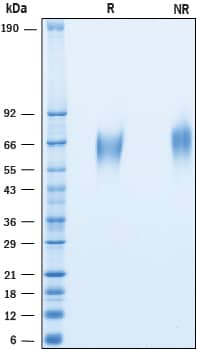Recombinant Cynomolgus CD200R1 His-tag Protein, CF
R&D Systems, part of Bio-Techne | Catalog # 10055-CD

Key Product Details
Product Specifications
Source
Human embryonic kidney cell, HEK293-derived cynomolgus monkey CD200R1 protein
Ala27-Leu267, with a C-terminal 6-His tag
Ala27-Leu267, with a C-terminal 6-His tag
Purity
>95%, by SDS-PAGE visualized with Silver Staining and quantitative densitometry by Coomassie® Blue Staining.
Endotoxin Level
<0.10 EU per 1 μg of the protein by the LAL method.
N-terminal Sequence Analysis
Ala27
Predicted Molecular Mass
28 kDa
SDS-PAGE
60-67 kDa, reducing conditions
Activity
Measured by its binding ability in a functional ELISA.
When Recombinant Cynomolgus Monkey CD200 R1 is coated at 0.5 μg/mL (100 μL/well), the concentration of Recombinant Human CD200 Fc Chimera (Catalog # 2724-CD) that produces 50% optimal binding response is 0.02-0.12 μg/mL
When Recombinant Cynomolgus Monkey CD200 R1 is coated at 0.5 μg/mL (100 μL/well), the concentration of Recombinant Human CD200 Fc Chimera (Catalog # 2724-CD) that produces 50% optimal binding response is 0.02-0.12 μg/mL
Scientific Data Images for Recombinant Cynomolgus CD200R1 His-tag Protein, CF
Recombinant Cynomolgus CD200R1 His-tag Protein Binding Activity
When Recombinant Cynomolgus Monkey CD200 R1 (Catalog # 10055-CD) is coated at 0.5 µg/mL, 100 µL/well, Recombinant Human CD200 Fc Chimera (Catalog # 2724-CD) binds with an ED50 of 0.02-0.12 µg/mL.Recombinant Cynomolgus CD200R1 His-tag Protein SDS-PAGE
2 μg/lane of Recombinant Cynomolgus Monkey CD200 R1 was resolved with SDS-PAGE under reducing (R) and non-reducing (NR) conditions and visualized by Coomassie® Blue staining, showing bands at 60-67 kDa.Formulation, Preparation and Storage
10055-CD
| Formulation | Lyophilized from a 0.2 μm filtered solution in PBS. |
| Reconstitution | Reconstitute at 1 mg/mL in water. |
| Shipping | The product is shipped at ambient temperature. Upon receipt, store it immediately at the temperature recommended below. |
| Stability & Storage | Use a manual defrost freezer and avoid repeated freeze-thaw cycles.
|
Background: CD200R1
References
- Rosenblum, M.D. et al. (2006) J. Dermatol. Sci. 41:165.
- Gorczynski, R.M. (2005) Curr. Opin. Invest. Drugs 6:483.
- Barclay, A.N. et al. (2002) Trends Immunol. 23:285.
- Wright, G.J. et al. (2003) J. Immunol. 171:3034.
- Vieites, J.M. et al. (2003) Gene. Jun. 5; 311:99.
- Shiratori, I. et al. (2005) J. Immunol. 175:4441.
- Cherwinski, H.M. et al. (2005) J. Immunol. 174:1348.
- Fallarino, F. et al. (2004) J. Immunol. 173:3748.
- Wright, G.J. et al. (2001) Immunology 102:173.
- Hoek, R.M. et al. (2000) Science 290:1768.
- Hatherley, D. and A.N. Barclay (2004) Eur. J. Immunol. 34:1688.
- Jenmalm, M.C. et al. (2006) J. Immunol. 176:191.
- Zhang, S. et al. (2004) J. Immunol. 173:6786.
- Vaine, C.A. et al. (2014) Adv Immunol.121: 191.
- Hernangómez, M. et al. (2014) Curr Pharm Des. 20:4707.
Long Name
CD200 Receptor 1
Alternate Names
CD200 R1, MOX2R
Gene Symbol
CD200R1
UniProt
Additional CD200R1 Products
Product Documents for Recombinant Cynomolgus CD200R1 His-tag Protein, CF
Product Specific Notices for Recombinant Cynomolgus CD200R1 His-tag Protein, CF
For research use only
